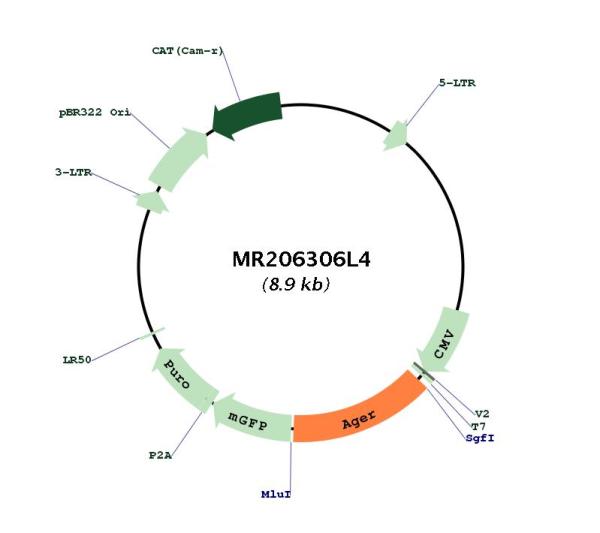Ager (NM_007425) Mouse Tagged Lenti ORF Clone
CAT#: MR206306L4
- LentiORF®
Lenti ORF clone of Ager (mGFP-tagged) - Mouse advanced glycosylation end product-specific receptor (Ager)
"NM_007425" in other vectors (4)
Interest in protein/lysate? Submit request here!
USD 365.00
Specifications
| Product Data | |
| Type | Mouse Tagged ORF Clone |
| Tag | mGFP |
| Symbol | Ager |
| Synonyms | RAGE |
| Vector | pLenti-C-mGFP-P2A-Puro |
| E. coli Selection | Chloramphenicol (34 ug/mL) |
| Mammalian Cell Selection | Puromycin |
| Sequence Data |
The ORF insert of this clone is exactly the same as(MR206306).
|
| Restriction Sites |
SgfI-MluI
Cloning Scheme for this gene
Plasmid Map

|
| ACCN | NM_007425 |
| ORF Size | 1209 bp |
| OTI Disclaimer | Due to the inherent nature of this plasmid, standard methods to replicate additional amounts of DNA in E. coli are highly likely to result in mutations and/or rearrangements. Therefore, OriGene does not guarantee the capability to replicate this plasmid DNA. Additional amounts of DNA can be purchased from OriGene with batch-specific, full-sequence verification at a reduced cost. Please contact our customer care team at custsupport@origene.com or by calling 301.340.3188 option 3 for pricing and delivery. The molecular sequence of this clone aligns with the gene accession number as a point of reference only. However, individual transcript sequences of the same gene can differ through naturally occurring variations (e.g. polymorphisms), each with its own valid existence. This clone is substantially in agreement with the reference, but a complete review of all prevailing variants is recommended prior to use. More info |
| OTI Annotation | This clone was engineered to express the complete ORF with an expression tag. Expression varies depending on the nature of the gene. |
| Product Components | The ORF clone is ion-exchange column purified and shipped in a 2D barcoded Matrix tube containing 10ug of transfection-ready, dried plasmid DNA (reconstitute with 100 ul of water). |
| Reconstitution | 1. Centrifuge at 5,000xg for 5min. 2. Carefully open the tube and add 100ul of sterile water to dissolve the DNA. 3. Close the tube and incubate for 10 minutes at room temperature. 4. Briefly vortex the tube and then do a quick spin (less than 5000xg) to concentrate the liquid at the bottom. 5. Store the suspended plasmid at -20°C. The DNA is stable for at least one year from date of shipping when stored at -20°C. |
| Reference Data | |
| RefSeq | NM_007425.3, NP_031451.2 |
| RefSeq Size | 1387 bp |
| RefSeq ORF | 1209 bp |
| Locus ID | 11596 |
| UniProt ID | Q62151 |
| Cytogenetics | 17 B1 |
| Gene Summary | Mediates interactions of advanced glycosylation end products (AGE). These are nonenzymatically glycosylated proteins which accumulate in vascular tissue in aging and at an accelerated rate in diabetes. Acts as a mediator of both acute and chronic vascular inflammation in conditions such as atherosclerosis and in particular as a complication of diabetes. AGE/RAGE signaling plays an important role in regulating the production/expression of TNF-alpha, oxidative stress, and endothelial dysfunction in type 2 diabetes. Interaction with S100A12 on endothelium, mononuclear phagocytes, and lymphocytes triggers cellular activation, with generation of key proinflammatory mediators. Interaction with S100B after myocardial infarction may play a role in myocyte apoptosis by activating ERK1/2 and p53/TP53 signaling. Can also bind oligonucleotides. Receptor for amyloid beta peptide. Contributes to the translocation of amyloid-beta peptide (ABPP) across the cell membrane from the extracellular to the intracellular space in cortical neurons. ABPP-initiated RAGE signaling, especially stimulation of p38 mitogen-activated protein kinase (MAPK), has the capacity to drive a transport system delivering ABPP as a complex with RAGE to the intraneuronal space. RAGE-dependent signaling in microglia contributes to neuroinflammation, amyloid accumulation, and impaired learning/memory in a mouse model of Alzheimer disease.[UniProtKB/Swiss-Prot Function] |
Documents
| Product Manuals |
| FAQs |
| SDS |
Resources
Other Versions
| SKU | Description | Size | Price |
|---|---|---|---|
| MC208117 | Ager (untagged) - Mouse advanced glycosylation end product-specific receptor (Ager), (10ug) |
USD 686.00 |
|
| MG206306 | Ager (tGFP-tagged) - Mouse advanced glycosylation end product-specific receptor (Ager) |
USD 886.00 |
|
| MR206306 | Ager (Myc-DDK-tagged) - Mouse advanced glycosylation end product-specific receptor (Ager) |
USD 686.00 |
|
| MR206306L3 | Lenti ORF clone of Ager (Myc-DDK-tagged) - Mouse advanced glycosylation end product-specific receptor (Ager) |
USD 986.00 |
{0} Product Review(s)
Be the first one to submit a review






























































































































































































































































 Germany
Germany
 Japan
Japan
 United Kingdom
United Kingdom
 China
China


